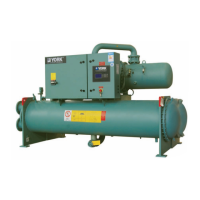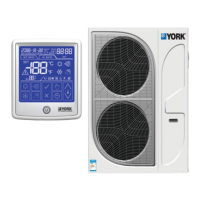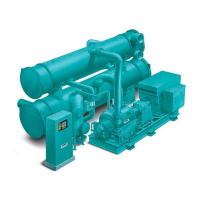7 Operation
7.1 General Description
The units are designed to work independently, or in
conjunction with other equipment via a 485 communic-
ation devices.During operation, the unit controller monitor
the chilled or hot liquid system temperature leaving the
unit and take the appropriate action to maintain this te-
mperature within desired limits.The compressor will aut-
omatically regulate the slide valve position to match the
cooling or heating load of the system.The heat removed
from the chilled liquid is then rejected via the water
cooled condenser.
The following sections give an overview of the operation
of the unit.For detailed information, Refer to detail instr-
uctions on the operation of control System on section 5.
7.2 Start-up
Check the main power supplies to the unit are 'ON', all
refrigerant service valves are open (anti-clockwise one
turn short of fully open) and both chilled and cooling
liquid have a regular flow rate, then press the 'START' key
on the keypad.
The controller will perform a pre-check to ensure that if
there is any the daily/holiday schedule or remote
interlocks to prohibit the unit to run, and all safety cut-
outs are satisfied and the cooling or heating load is
required (i.e.that the chilled liquid temperature is outside
the set limits).Any problems found by the pre-check will
be displayed.If no problems are found and cooling/heating
load is required, the compressor will start.
7.3 Normal Running and Cycling
Once the unit has been started, all operations are fully
automatic.After an initial period at minimum capacity on
the compressor, the control system will adjust the unit
load depending on the chilled liquid temperature and rate
of temperature change. If very little heat load is
present,the compressor will continue at minimum capacity
or performe cycling shutdown to avoid overcooling the
liquid. In that case,the compressor will restart autom-
atically when the liquid temperature rise again.
Once the compressor is running, the evaporated refrigerant
vapor is pumped into the water cooled condenser, which
results in the rise of discharge pressure.
Once the compressor is running the controller monitors oil
pressure, motor current, and various other system
parameters such as discharge pressure, chilled liquid
temperature, etc. Should any problems occurs, the control
system will immediately take appropriate action and display
the nature of the fault (Refer to instructions on the operation
of control System on section 5).
After the chiller stop, the check valve of compressor may
send out some noises, which is caused by the internal
refrigerant equalizing due to the pressure differential.It is a
normal phenomenon and has no influence on the
performance and reliability of chiller.
Oil and Refrigerant
The lubricant should be replaced periodically according to
the advice of York to ensure that the unit can be in normal
running.
The moisture indicating sight glass located in the liquid line
under the condesner should be inspected periodically, please
contact York in time once any moisture is found in the
system.It should be handled by the YORK service personnel
otherwise the compressor will possibly be damaged.
For YEWS100H/130H/170H/200H/210H, the oil sump is
located inside the compressor built-in oil separator, are an
oil drain hole and an oil charge valve at the bottom of the
compressor. In purpose of drain the oil as quickly as
possible, movable joint is used for easier connection to
flexible conduit.
For YEWS100P/130P/170P/200P/215P, the oil sump is
located at the bottom of the oil separator inside of the
condenser. Following picture shows the details for service
of the oil sump external connection. It’ s easy to connect
with hose and add lubrica-ting oil quickly. There is no
continuous oil level will exist in the sight glass of the
compressor and the oil filter is on the oil supply line.
YEWS-E Water Cooling Screw Chiller/Heat Pump
52

